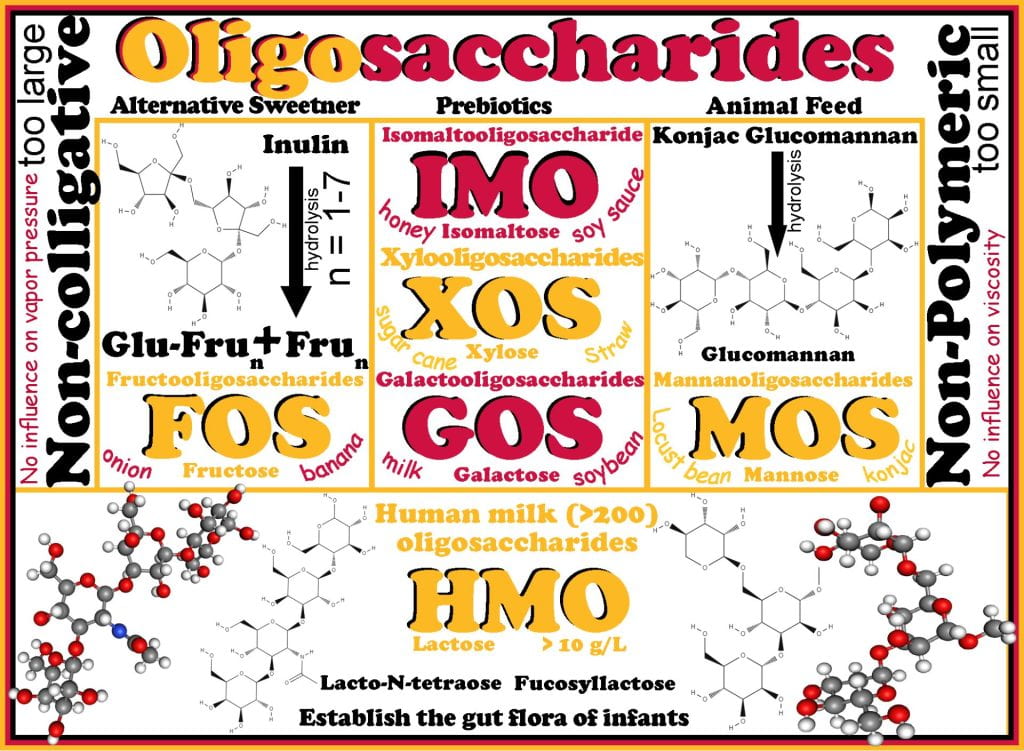
Oligosaccharide Structures and Uses
Beyond disaccharides, oligosaccharides range from three to nine monomers, while others include saccharide chains as long as twenty. Oligosaccharides naturally occur in whole foods, are fermented by bacteria and yeasts, and are manufactured through polysaccharide hydrolysis. Oligosaccharides differ in the number, modification, and heterogeneity of sugar monomers, type of glycosidic bonds, and presence or absence of branching. Common sugar modifications for oligosaccharides and polysaccharides include losing hydroxyl group(s) (deoxy-) and adding methyl, amino, or other functional groups.

Most oligosaccharides are not hydrolyzed nor absorbed in the small intestine; instead, they enter the colon intact and act as a prebiotic for the gut microbiome to utilize as an energy source during anaerobic fermentation. Oligosaccharides’ larger molecular mass precludes them from having colligative properties as they do not significantly alter the fugacity of water. Oligosaccharides do not have a large enough molecular mass to entangle and do not alter viscosity or form gels.
Most interest in oligosaccharides focuses on their prebiotic and biological functions. Few industrial applications as techno-functional ingredients exist; fructooligosaccharides (FOS), manufactured from the hydrolysis of inulin, a polysaccharide of fructose, are used as an alternative sweetener and naturally found in bananas and onions. Isomaltooligosaccharide (IMO) (VitaFiberTM) contains glucose oligomers with alpha-(1-6)-linkages and a relative sweetness equal to ~60% of sucrose found naturally at low levels in honey and soy sauce and manufactured through the enzymatic hydrolysis of starch using alpha-glucosidase, alpha-amylase, and pullulanase, to obtain mono-, di-, trisaccharides and other oligosaccharides with alpha- 1,4 and alpha-1,6 glycosidic linkages. Glucose is removed through yeast fermentation, and the remaining maltose syrup is enzymatically treated using tranglucosidase to convert alph-1-4 linkages to alpha-1-6 resulting in IMO. Examples of prebiotics include xylooligosaccharides (XOS) extracted from the waste bagasse of sugar cane and wheat straw or rice husks and galactooligosaccharides (GOS) found in dairy products and soybeans. GOS is often added to infant formula to help establish the gut microbiome. Another oligosaccharide of industrial importance is mannanoligosaccharides (MOS) which are manufactured from locust bean and konjac gums through their hydrolysis and added to animal feed to improve energy conversion, but also because MOS prevents adherence of pathogens to intestinal cells as MOS bind to the adhesins on pathogens. Human milk oligosaccharides (HMO) contain more than 200 unique molecules based on the monosaccharide lactose and the third most abundant molecule in breast milk, following lactose and lipids. HMOs provide beneficial intestinal bacteria, specifically bifidobacteria, an energy source ensuring colonization while acting as a decoy receptor for pathogens.


